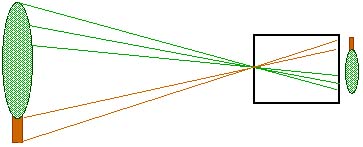|
|

|
|


Look at the rays of light in the sketch of the pin-hole camera
in Figure 19.1. From each point on the object there are rays of
light leaving in every possible direction. A few of the rays of
light coming from the top of a tree are shown in the sketch. Only
one of those rays passes through the pin-hole and arrives
at the back of the camera. That is true for every point on the
object. From each point on the object only one ray of light will
pass through the pin-hole. Each of these rays that pass through
the pin-hole will have a different direction, as illustrated in
Figure 19.2 for rays coming from several different points on the
tree. That means each of these rays strikes the back of the camera
at an appropriate place to produce a clear, sharp image.

An interesting feature of a pin-hole camera is that it produces
a sharp image regardless of the object distance as sketched
in Figure 19.3. There, a sharp image is produced from a far distant
tree and a nearby face. This is because only a single ray (or
a very tiny bundle of rays) from each point on the object
passes through the pin-hole and continues on to a unique
point on the image.

With such a tiny opening or aperture to admit light in a pin-hole
camera, the image may be dim. Using a larger aperture (perhaps
a "nail-hole" instead of a pin-hole) will make the image
brighter. But, with more rays of light from each point on the
object, the image becomes blurred. As indicated in Figure 19.4,
light from each individual point on the object now creates a blurred
circle on the image and these fuzzy dots overlap. The image is
now brighter-but blurred.

A lens in the opening can be used to focus the image
as in Figure 19.5. Now the image will be sharp only for a particular
object distance do. Usually the focal length of the
lens f is fixed. To focus on nearby or far away objects requires
that the image distance di be changed; when you focus
a camera, you are adjusting this distance between the lens and
the film.

As the aperture of a lens is made smaller, or "stopped down",
the camera behaves more like a pin-hole camera and focus becomes
less critical. The range of object distances for which the image
is reasonably clear is called the "depth of field".
Stopping down a lens to a smaller apeture increases its depth
of field. This can be seen from Figure 19.6 where the lens is
focused to provide a sharp, well-focused image of a distant object
on the film. A more nearby object (shown inverted only to keep
the two distinct) will have its image somewhere beyond the plane
of the film. Each point on the object will have a "circle
of confusion" on the film. For a wide aperature the film
will record a rather fuzzy, blurred image, but as the aperature
is made smaller the "circles of confusion" will be smaller
and the film will record a sharper image. This can be used for
creative effects by causing something in the foreground or background
to blur while the main subject is sharply focused. This can be
seen in the photos of Figure 19.7. It must be considered when
changing lens setting and shutter speed.


A typical modern photographic lens is illustrated in Figure 19.8.
Such lenses are far more complex than the simple, single-element
lenses we discussed in the previous chapter but the general behavior
and purpose remain the same.

|
|